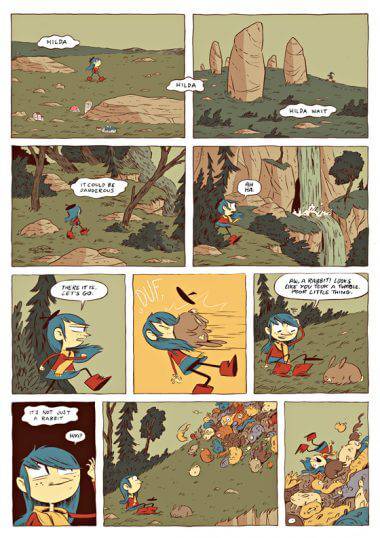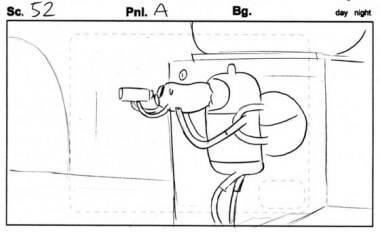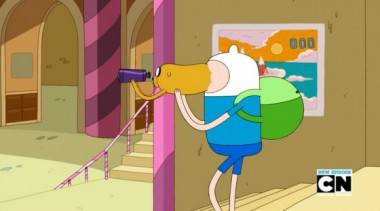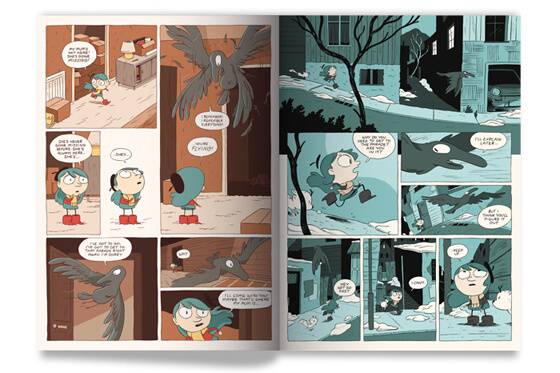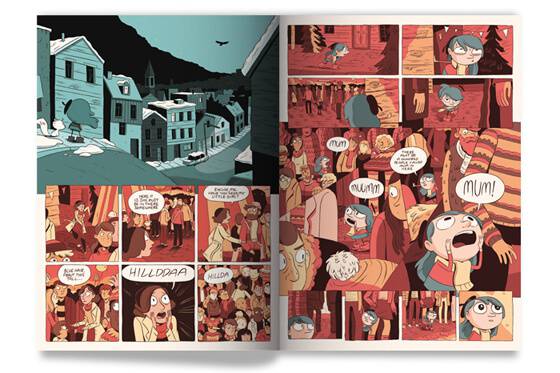Q&A with artist Luke Pearson
Earlier last month we posted a review of the new addition to Luke Pearson‘s phenomenal children book series Hilda, a tale of an adventurous young girl in a wold of folk tales, giants and mystery. Told in the classic graphic novel layout the Hilda series is enjoyed by young and old a like. Pearson is forging a place for himself in comic culture with dozens of books, tips and editorials in his name. Most recently Pearson has worked on storyboards for the hit Cartoon Network show Adventure Time. We managed to grab some time with Luke and discuss the success and future of Hilda and the joy of fulfilling a child hood dream of working in animation (well who can blame him?)
What inspirations from the world of art have you called upon to make your own work?
I guess most of my direct influences comes from the indie comics, manga and cartooning world. A messy list of artists I think about a lot would include Tove Jansson, David B, Osamu Tezuka, Chris Ware, Dan Clowes, Kevin Huizenga, Gene Deitch, Lilli Carré, Michael Deforge, Ron Regé, Kerascoët, Nicolas Bentley, Dash Shaw, Seiichi Hayashi, Albert Uderzo, Theodor Kittelsen.
Some animation influences (though this would somewhat cross over with the previous list) would include Yuri Norstein, Miyazaki, Soviet era Soyuzmultfilm and John and Faith Hubley. Recently I’ve been thinking a lot about Smallfilms and CMTB animation.
I also like a lot of book and poster design. These are all pretty insular influences but I try to just broadly be interested in as much as I can. Music, fine art and fiction obviously inspire me too, but in the same way that just wandering around can inspire me.
Could you talk me through a little of your process and how you go about making your illustrated work?
My process is pretty boring and straightforward. I tend to draw and ink on paper, then edit, colour and mess around a lot in Photoshop. I started to occasionally ink digitally with a tablet a while ago. I moved on to a Cintiq, but apart from being better for my wrist I find it’s weirdly not that much easier to use than a tablet and I’m thinking of getting rid of it.
I see you’ve worked on some animation like Adventure Time, how would you feel about your work being developed into animation?
I’m yet to properly see my own work animated, but the idea of it is nice obviously. Seeing the first finished episode I boarded for Adventure Time was probably one of the most exciting moments of my career so far. It’s sort of a childhood dream, watching a cartoon and seeing the characters do things you made them do. I’ve always been into animation and animation design has always influenced my comics and illustration work so I hope I can carry on being involved in that world in some way.
You have created a lot of comics as well as being involved in many anthologies, editorials and of course your Hilda series, what are you most proud or happy with?
I guess probably the Hilda series as a whole. I can’t feel too proud of any one individual book because they’re full of things I wish I’d done better, but I’m proud that I’ve managed to sustain something to the point where it feels somewhat substantial. And that people generally seem to still like it. I feel really happy when I get a letter from a kid telling me what they think the next book should be about. Most other things that I’ve done feel like blips and experiments.
When did you develop the character of Hilda?
I probably first started drawing her in 2009. The first comic was out in 2010 so I was figuring her out for maybe a year leading up to that.
How do you go about creating such a rich and engaging world as found in the Hilda series? Do you have multiple sketchbooks of the world in Hilda stories or to you create it as it becomes necessary to tell a particular story?
Honestly I’ve mostly made stuff up as I go along. There are details and rules about the world that exist in my head which kind of guide the choices I make, but I’ve never really written stuff down unless I’m planning a specific story. Actually I have done a few times, but more as an exercise in figuring things out and getting my head in the right place when I needed to come up with a new story. I certainly don’t have specific sketchbooks full of secret information though. My feeling is that it’s the wrong approach to try and figure all that stuff out first. You want that information to unfurl naturally and it seems to me that the most natural way to achieve that is to let it unfurl itself while you focus on telling a decent story.
A lot of the things that make up Hilda’s world come straight from folklore so that certainly helps anyway. A lot of it is just arranging and interpreting existing concepts in a particular way.
How long do you foresee the story of Hilda to be?
I don’t entirely know. I like the episodic nature of the series so far and I’m not building towards a particular ending. I may take a break and build towards some kind of climax to signify that. But if I did then I’d like to revisit her later in life. Maybe it’d pick up where it left off or maybe she’d be older by then. I don’t know.
Hilda has a very adventures childhood – what was your own childhood like?
The opposite of that. I’ve always been frustratingly shy. I stayed in doors and drew a lot and avoided talking to people. Which I guess I still do. It never felt like a choice though so Hilda sort of represents the kid I would have liked to have been, or even the kind of person I would still like to be. There are some connections though. I was a scout and the camping sequence in The Black Hound is pretty strongly based on real experiences.
In your newest book Hilda has to deal with a big black dog, as well as deal with the feeling that she is disappointing her mother. It is interesting to see the comparison between these two sorts of dramas, the fantastical and the incredibly relatable. Can you tell me a little about the story and how it was created?
The original focus of the story was actually the Nisse, a kind of house spirit. I named them after the creature from Scandinavian folklore but the ones in the comic have elements of Brownies and similar creatures from different folk traditions. I always try to find a balance between the fantastic and the everyday and a story about a house spirit who didn’t have a house seemed like a good angle for that. I tried to touch on a theme of homelessness and compassion because I often think about the way I viewed homeless people as a child and I’m appalled.
Anyway, once I’d established their situation in the story and how their ‘nowhere spaces’ worked, then I came up with the idea of the Hound (which was originally some nondescript spirit) and how that could intersect with their story in an interesting way. I decided to make Hilda join the scouts for fairly technical reasons (to give her something to do without resorting to showing her going to school) but once I’d decided that, I started to put a lot of my own scouting experiences and anxieties in there and that kind of became the driving force of the story. It gave the whole thing an arc and I could then slot all the other pieces in around it.
What’s next for you, and what are you working on currently?
Right now I’m finishing up work on another couple of Adventure Time boards while tentatively edging into some new comic projects.
You can purchase all of Luke’s books over at Flying Eye Books and Nobrow


